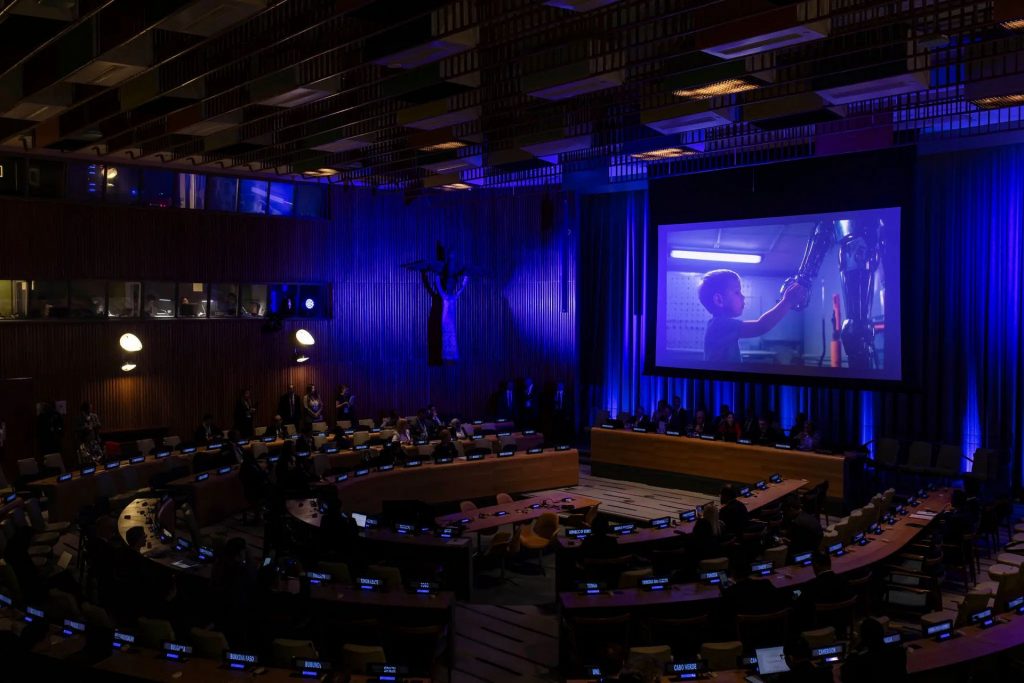The UN’s AI Gambit: Guardrails or Global Gridlock? This week, the United Nations didn’t just join the AI conversation—it tried to seize the mic. At the 80th General Assembly, the UN launched a sweeping initiative to shape the future of artificial intelligence through a new framework for global governance. The message was clear: AI’s trajectory must not be dictated by a handful of tech giants or geopolitical superpowers. The stakes? Nothing less than the rules of intelligence itself.

🏛️ The Blueprint: Dialogue and Science
The UN’s plan rests on two newly minted bodies:
- Global Dialogue on AI Governance: A multilateral forum where all 193 member states, plus civil society and industry, can exchange best practices and coordinate oversight.
- Independent International Scientific Panel on AI: A 40-member team of scientists tasked with producing annual reports on AI’s risks, opportunities, and societal impacts. Think IPCC for algorithms.
These bodies were formalized under Resolution A/RES/79/325, adopted unanimously in August 2025. UN Secretary-General António Guterres hailed the move as “a significant step forward in global efforts to harness the benefits of artificial intelligence while addressing its risks”.
🌍 The Split Screen: U.S. vs. China
The initiative immediately exposed a fault line in global AI politics.
- 🇺🇸 United States: Michael Kratsios, speaking on behalf of the Trump administration, rejected centralized AI governance outright. He argued that global regulation would stifle innovation and that American-led AI should remain the benchmark5. The U.S. continues to favor voluntary industry commitments and deregulation, as outlined in its 2025 AI Action Plan.
- 🇨🇳 China: Premier Li Qiang, at the World AI Conference in Shanghai, proposed a global cooperation body for AI governance. China’s stance emphasizes collective oversight, open-source development, and equitable access—especially for the Global South8.
This ideological clash—between deregulated dominance and coordinated stewardship—is now playing out on the world’s biggest diplomatic stage.
🧨 The Red Lines: Nobel Voices Enter the Chat
Adding moral weight to the debate, over 200 Nobel laureates, scientists, and former heads of state issued a Global Call for AI Red Lines. Their plea? Define what AI must never be allowed to do—before it’s too late. Suggested prohibitions include:
- Lethal autonomous weapons
- Autonomous replication of AI systems
- AI involvement in nuclear warfare
Maria Ressa, Nobel Peace Prize winner, warned: “Information integrity is the mother of all battles. Win this, and we can win the rest. Lose this, and we lose everything”.
Yuval Noah Harari added: “Humans must agree on clear red lines for AI before the technology reshapes society beyond our understanding and destroys the foundations of our humanity.”
⚖️ The Implications: Who Gets to Decide?
The UN’s move is historic—but fragile. The Scientific Panel must avoid becoming a political pawn. The Global Dialogue must resist devolving into an echo chamber of state interests. And the entire framework must keep pace with a technology that evolves faster than any treaty ever written.
Critics warn that without binding enforcement, the initiative risks becoming symbolic. Others argue that even symbolic guardrails are better than none—especially when AI’s misuse could destabilize democracies, weaponize disinformation, or exacerbate global inequality.

🥜 Final Nut: The Intelligence Arms Race Has a New Arena
We’re witnessing a geopolitical tug-of-war not over land or oil, but over the architecture of intelligence itself. The UN’s initiative won’t stop AI from racing ahead—but it might slow down the worst instincts of power. In a world where algorithms increasingly shape reality, even a few guardrails could make all the difference.
The question isn’t whether AI will change the world. It’s who gets to decide how—and for whom.
🧠 Core UN Governance Sources
| Source | Title | Key Insight |
|---|---|---|
| UN News | UN moves to close dangerous void in AI governance | Official UN coverage of the Global Dialogue and Scientific Panel launch |
| IPPDR | Understanding the New UN Resolution on AI Governance | Deep dive into Resolution A/RES/79/325 and its implications |
| TechPolicy.Press | UN Launches AI Panel and Dialogue, But Questions Linger | Critical analysis of inclusion, independence, and representation issues |
| Middle East Observer | UN Establishes 40-Member AI Panel to Guide Policymakers | Overview of the panel’s structure and annual reporting model |
🌍 Geopolitical Reactions
| Source | Title | Key Insight |
|---|---|---|
| MSN | Kratsios on AI: That Other Really Notable UN Speech | U.S. rejection of centralized AI governance and push for American-led innovation |
| White House PDF | America’s AI Action Plan | Full breakdown of U.S. AI strategy under Trump, emphasizing deregulation |
| Shanghai Gov | China proposes global cooperation body on AI | China’s support for multilateral governance and open-source development |
| China MFA | Global AI Governance Action Plan | China’s official framework for inclusive, equitable AI governance |
🧨 Nobel Call for Guardrails
| Source | Title | Key Insight |
|---|---|---|
| CNBC | Nobel Prize winners call for binding international ‘red lines’ on AI | Open letter from 200+ experts urging limits on lethal AI, replication, and nuclear use |
| NBC News | UN General Assembly opens with plea for binding AI safeguards | Maria Ressa and Yuval Harari’s speeches on existential risks and moral urgency |
Any questions leave a comment below or Contact Us here.
- The BYDFi MoonX Migration Trap: A Custodial Rug in Disguise
- 🎭 Masterclass Mirage: How “Education” Became a Sales Strategy
- The U.S. Bets $1B on AI Supercomputers to Cure Cancer: But Biology Isn’t Code
- “The Public Isn’t Buying the AI Race: And They’re Not Quiet About It”
- 🏗️ When Progress Becomes Parasitic: The Hidden Cost of Data Centers


Leave a Reply